Ibn Taymiyyah’s Medieval Inghimas Tactic as Daesh’s Modern Propaganda Instrument
Keywords:
Ibn Taymiyyah, inghimas, Daesh, Propaganda, Tactic, AttackAbstract
Inghimas originated from the work of the medieval scholar Ibn Taymiyyah as an asymmetric and practicable “jihad” (holy war) tactic. This was intended to be a means for plunging destructively into the “infidel” enemy’s frontlines for “benefitting the cause of Muslims” and “serving Islam”. The other objectives behind the use of this tactic were to inspire fellow Muslims to fight, and to earn “martyrdom at the hands of the enemy”. Based on its scholarly justification and apparent repurposing potential, this original paper investigates whether Daesh as a modern jihadist organization has additionally reinvented inghimas for the fulfillment of ends that extend beyond its originally intended military purpose. Methodologically relying on thorough research that involved studying various open-source primary and secondary resources, this paper reveals that Daesh has, indeed, adapted inghimas to the production of audio, video, and text propaganda suited to 21st-century digital media. Thus, this tactic in all its various forms, and even its practitioners, are presented tactfully for public consumption in important ways. Such propaganda pertains to either claiming responsibility for recent assaults or urging further attacks, aimed at different audiences. The group thus exploits inghimas for vital outreach purposes in the digital era, in addition to its physical military utility. Effective countering of such a lethal tactic will require nothing short of deconstructing its scholarly foundations. This study carries both academic and policy significance as it sheds light on an unaddressed international security predicament, whose continued neglect will have dangerous consequences for jihadist radicalization and recruitment.

